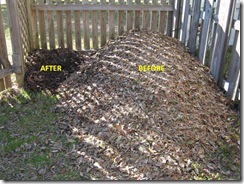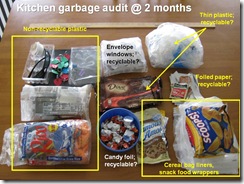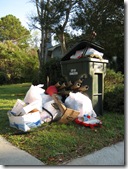Waste: It’s true, my trash doesn’t stink.
The Charleston Green Plan estimates that 300,000 tons of household waste is generated annually in Charleston County. The 2000 Census estimated the household population of Charleston County at just under 333,600 individuals; thus, that’s an average of approximately 1800 pounds of household waste per person per year. If every time we put out our 96-gal green City garbage bins they weighed 100 lbs, that equals 18 City garbage bin per person per year. I generate about one bin’s worth per year.
The nearly universal reaction when people learn that I throw out the equivalent of one City garbage bin per year is utter disbelief, followed by great curiosity and a desire for an explanation of how. Like all things Eco-Cents, the answer is quite simple.
First, I make a conscious effort to purchase products without packaging, or that have minimal packaging which can be composted or recycled. Even at just one City garbage bin per year, I still have room for improvement.
Second, I subscribe to the philosophy of BYO (Bring Your Own). I keep re-usable bags in my car for shopping, and at the grocery store I purchase deli meat in a re-usable Tupperware container that I supply (which also keeps the meat fresher). Number 6 Styrofoam (meat trays and egg cartons) can also be recycled at Publix. Following a challenge from a local high school student who asked if I used my own cup at Burger King (to which I indicated that I try not to eat fast food), I have started keeping a cup (that I wash in between uses) in my car cup holder for occasions when I grab a bite to eat at an establishment where re-usable cups are not available for fountain drinks.
Paper and paperboard (cereal boxes, ice cream containers, etc.) are now picked up at curbside recycling along with metal, glass and plastic, and in total recycling diverts about 80% of packaging that enters my home away from the landfill (formerly the incinerator).
 I have also become a staunch advocate of composting. The majority of my composting effort goes into making ‘black gold’ out of fallen oak leaves each spring, which reduces the need to haul off about 10 City garbage bin’s worth of yard debris annually (though that material would be commercially composted) and provides an incredibly nutrient rich mulch and fertilizer for my gardening efforts. With respect to composting kitchen-generated materials, because my frozen food purchases almost exclusively consist of meat and ice cream, there’s plenty of room in my freezer for a container to store compostable food scraps until the container is full and ready for the bin outside; this also helps to keep the freezer fuller which in turn makes it run more efficiently, saving electricity. I also use the same approach with a smaller container for non-compostable food scraps, freshness packs and shrink wrap from meat packages, fish skin, grease, fat, etc. which prevents those products from stinking up the kitchen trash can while it slowly accumulates material.
I have also become a staunch advocate of composting. The majority of my composting effort goes into making ‘black gold’ out of fallen oak leaves each spring, which reduces the need to haul off about 10 City garbage bin’s worth of yard debris annually (though that material would be commercially composted) and provides an incredibly nutrient rich mulch and fertilizer for my gardening efforts. With respect to composting kitchen-generated materials, because my frozen food purchases almost exclusively consist of meat and ice cream, there’s plenty of room in my freezer for a container to store compostable food scraps until the container is full and ready for the bin outside; this also helps to keep the freezer fuller which in turn makes it run more efficiently, saving electricity. I also use the same approach with a smaller container for non-compostable food scraps, freshness packs and shrink wrap from meat packages, fish skin, grease, fat, etc. which prevents those products from stinking up the kitchen trash can while it slowly accumulates material.
 And lastly, I organize my trash. It sounds crazy initially, but once you realize how much space is wasted in a trash can when you just toss things in you’ll appreciate what I’m referring to. Because the trash that I do toss out consists primarily of cereal bag liners and other plastic “foil”, they are easily compacted into a single cereal bag liner until the liner is full, at which point I start another ‘bag within a bag’. Using this simple approach, it takes several months to fill up a 13-gal kitchen garbage bag (seven of which fit in a 96-gal garbage bin). As a finishing touch my kitchen garbage bag is a Bio-bag; however, because of resource-intensive growing requirements and fertilizer runoff associated with farming (which can be mitigated), moderate use of bio-bags or any bag for that matter remains paramount.
And lastly, I organize my trash. It sounds crazy initially, but once you realize how much space is wasted in a trash can when you just toss things in you’ll appreciate what I’m referring to. Because the trash that I do toss out consists primarily of cereal bag liners and other plastic “foil”, they are easily compacted into a single cereal bag liner until the liner is full, at which point I start another ‘bag within a bag’. Using this simple approach, it takes several months to fill up a 13-gal kitchen garbage bag (seven of which fit in a 96-gal garbage bin). As a finishing touch my kitchen garbage bag is a Bio-bag; however, because of resource-intensive growing requirements and fertilizer runoff associated with farming (which can be mitigated), moderate use of bio-bags or any bag for that matter remains paramount.
I don’t have kids and their consumptive needs, but I do have pets: the steel and/or tin wet food containers are recycled and the dry food is bought in bulk (about 20 x 16lb bags per year) and the bags compact nicely when empty. Pet waste is buried outside (my now spayed/neutered cats adopted me and don’t know how to use a litter box); although shallow burial is not ideal, it is probably no worse than composting it given the potential for disease transmission. Wheat-based biodegradable cat litter exists for savvy cats and the poop can be flushed and treated at the sewage treatment plant.
The composition and fate of the materials described above represents the typical pattern. Obviously projects around the house or cleaning up after a big storm are going to generate additional materials that require disposal, but still don’t put me anywhere near the average of 18 full City garbage bins per year.
I don’t expect anybody who reads this to actually reduce refuse generation to one City trash can per person per year overnight; however, it would be great if it inspired a systematic reduction in refuse generation across the board. Other westernized countries like Belgium and New Zealand restrict household waste generation, and it’s only a matter of time before such measures are implemented in the U.S. In at least one municipality in Canada, household garbage is limited to the equivalent of 20-gal per week which equates to 11 x 96-gal City of Charleston garbage bins per year; that’s 44% less than what the average Charleston County resident (not household), so we’ve clearly got some catching up to do.
To share YOUR advice or tips to further reduce trash generation, please click here.

